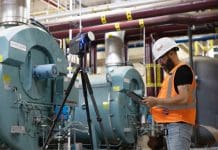Stuart Patience, senior associate specialising in Solar PV at Hollis explains how the industry can overcome the barriers to solar energy adoption in the UK
In the UK, buildings account for around 23 percent of all carbon emissions, with 30 percent of those coming from commercial buildings.
As we are all aware by now, buildings are a major contributor to climate change. In the UK, they account for around 23 per cent of all carbon emissions, with 30 per cent of those emissions coming from commercial buildings – both in terms of new build construction and the energy demand from existing buildings.
We’re perhaps less aware of just how much energy the sun generates. I was shocked to discover that in a single hour, the amount of sun power that strikes the earth is more than the entire world consumes in a year. And in a single year, it exceeds all known energy reserves of oil, coal, natural gas and uranium put together.
The uptake of solar energy is still low
Despite its huge potential, the most recent data shows the uptake of solar energy is still low, accounting for just 4 per cent of Britain’s total electricity generation. But with our planet reaching a climate change cliff edge, several UK energy suppliers going bust and Russia’s invasion of Ukraine driving oil and gas prices to their highest levels in nearly a decade, we are now being forced to reconsider our energy supplies.
As it stands, the UK’s total solar PV capacity sits at 14GW, but in order for the UK to meet its climate change target of being a net zero economy by 2050, the industry is looking to deploy 40GW by 2030.
There is no doubt there are significant policy barriers to the deployment of renewable energy, but our dependence on fossil fuels is not just a policy issue. The private sector, and in particular the real estate sector, has an important role to play in the transition towards a clean energy economy powered by renewables. Integrated within a robust ESG strategy, solar photovoltaic (PV) has the potential to move the real estate sector towards a more sustainable, resilient, flexible and secure future.
As a Solar PV expert at international independent real estate consultancy Hollis, I have witnessed first hand how high energy prices, forthcoming EPC changes, corporate net zero ambitions and tenants’ appetite to lower operational costs has resulted in more and more commercial property owners turning to rooftop solar PV systems to harness nature’s ‘free’ energy to power their buildings and equip them for the future.
But there are still a number of barriers which are impacting rapid widespread adoption. In this article, I’d like to address some of these barriers as well as some of the ways we help building owners mitigate them in an effort to reduce their building’s carbon footprint and help build a greener future.
The technology has been proven to consistently deliver forecasted returns in the UK climate. And yet, in my experience, lack of knowledge about solar technologies remains the one of the biggest barriers to investing in solar PV.
The quality of a PV system is vitally important and can be influenced by not only the conditions of the local environment where it is being installed, but also the hardware specified.
A solid example of this is China’s monopoly on the Solar PV manufacturing market. Globally, the country accounts for 97 per cent share of silicon wafers production, 79 per cent share of PV cells and 67 per cent share of polysilicon, as stated in a 2019 report released by Bloomberg NEF. This in turn, has led to cheaper solar PV panels being exported globally.
More than just the hardware and installation, landlords must also consider maintenance and repair costs. As solar PV panels become more widely available and cost effective, building owners need to be savvy. The cheapest deal is not necessarily the best one; saving money at the start with lower quality panels, inverters and mounting equipment may lead to unforeseen and costly issues further down the line, as they are more likely to encounter multiple maintenance issues and potential warranty claims.
To help mitigate this, at Hollis we are committed to procuring panels from ethical sources, not linked to alleged forced labour from China, with market-leading efficiency and robust guarantees. From a cost point of view, clients are typically seeing a return on investment of seven to nine years with a revenue stream of 25+ years.
On top of that, additional revenue streams can be set up, for example charging tenants through a separate solar PV Power Purchase Agreement (PPA) for energy generated and consumed on site or factoring into the lease. In addition, a Smart Export Guarantee (SEG) can be set up with an energy provider which pays the system owner for each unit exported back to the grid. This is why the planning phase is so critical.
Not only does it explore the feasibility of a solar PV system, including: roof space suitability (i.e. roof type, roof condition, skylights, shading from roof plant equipment, nearby buildings or trees); ease of roof accessibility for future maintenance, electrical infrastructure and existing electrical supply capacity and building demand. It also takes into account factors such as the landlord’s appetite for charging the tenant for the solar energy and the practicalities involved in that (as mentioned above).
We can also work closely with the landlord and the tenant to roadmap their future electrification plans which could include anything from heat pumps to electric vehicle charging, battery storage, process control and automation. And by making use of 3D modelling to look at one or sometimes multiple scenarios for system sizes and payback periods, we are able to evaluate the proportion of solar energy consumed on site and the amount exported to ensure your investment delivers the best returns.
A holistic approach to solar PV
This all forms part of Hollis’ holistic approach to solar PV projects whereby they are integrated within any existing ESG aspirations, or part of an overall building assessment, and value is added at every stage of the project lifecycle and beyond. From initial feasibility designs, specification development and contractor appraisal through to project management, performance reviews and ongoing maintenance.
Given what is happening in the world at the moment, both politically and environmentally, there is no doubt we need to wean ourselves off fossil fuels. The real estate sector has a pivotal role to play; we need to ensure we ride this wave and take real action in meeting net zero targets and ensuring energy security for millions of people across the UK. With the right approach to overcoming its barriers, rooftop solar PV offers a ray of hope.
Stuart Patience

Senior Associate specialising in Solar PV
Hollis
LinkedIn: Hollis
Twitter: @hollis_global














